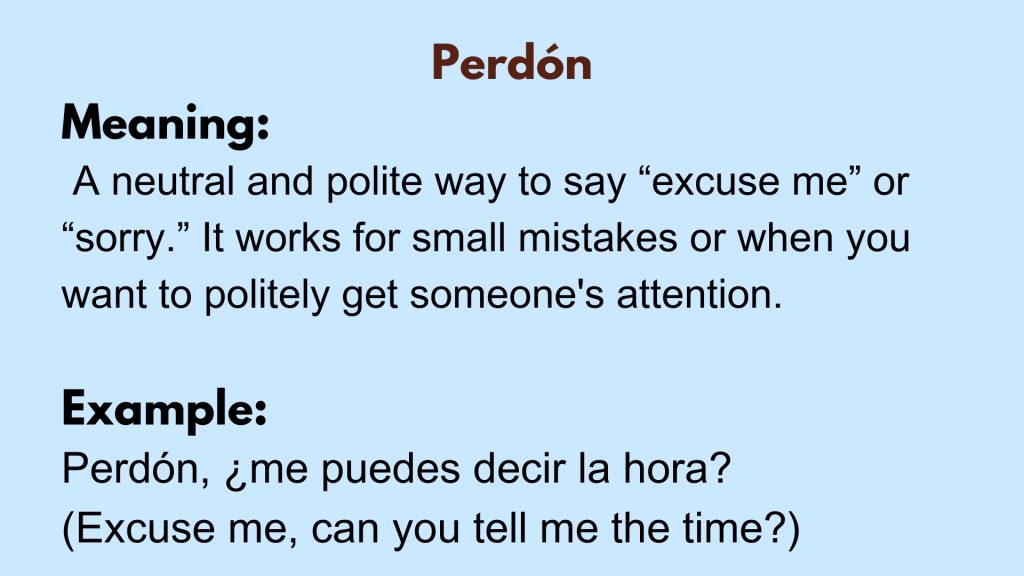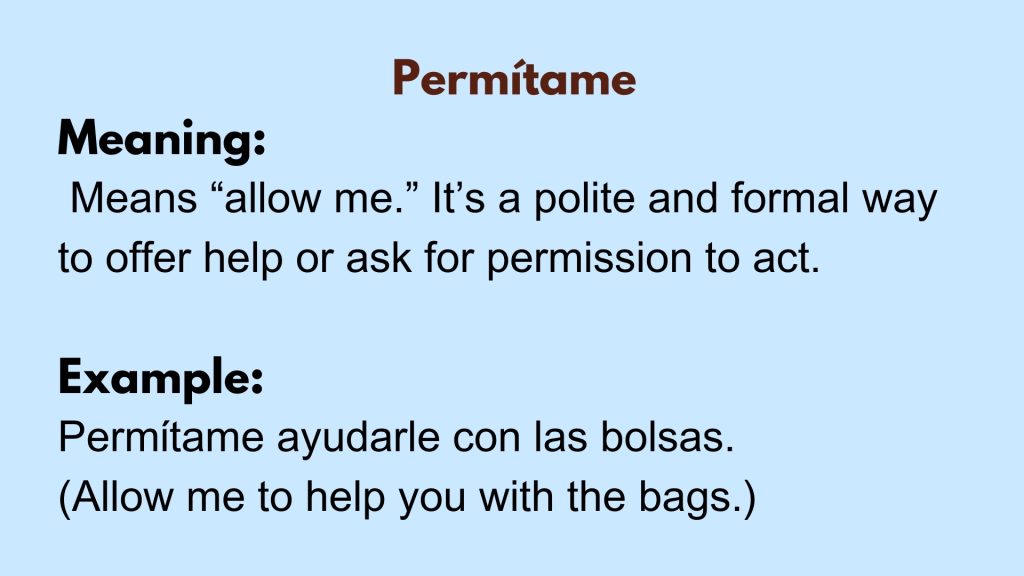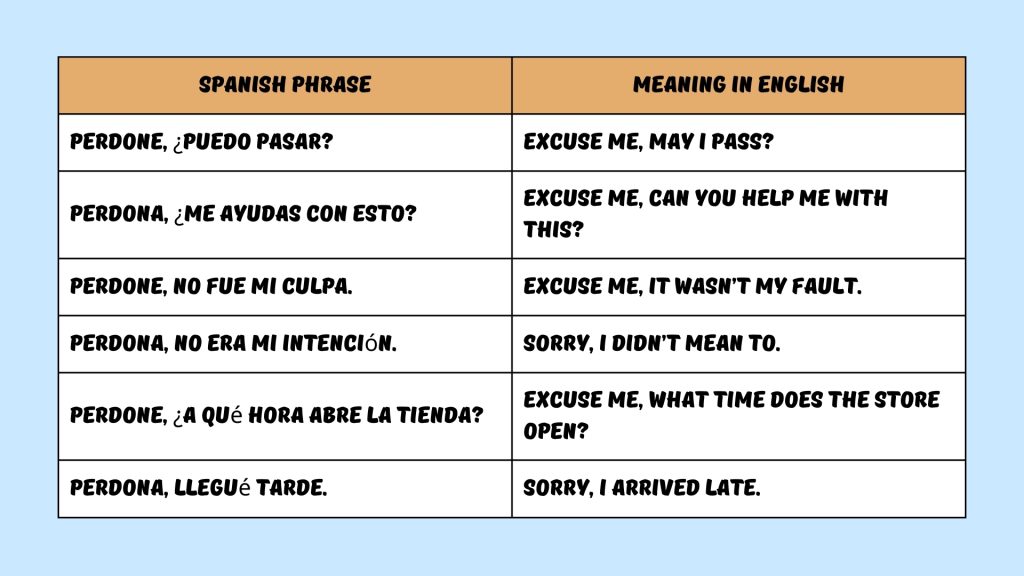When you’re learning Spanish and want to be polite in social settings, knowing how to say ‘Excuse me’ is essential.
You can say ‘Perdón’, ‘Perdona’, or ‘Perdone’. The choice depends on how formal the situation is and who you’re talking to. Each version fits different situations, whether you’re on a busy street or at a formal event.
Understanding these phrases helps you navigate cultural norms and avoid misunderstandings. It’s a simple way to show respect and ensure smooth communication.
Easy ways to say excuse me in the Spanish language
When it comes to being polite, there are a few simple ways to say ‘excuse me’ in Spanish. If you just need to get someone’s attention or ask them to repeat something, ‘Perdón’ works well.
When you’re in a more casual setting, you can say ‘Perdona,’ and in more formal situations, ‘Perdone’ is better.
If you need to get by someone or interrupt, just say ‘Permiso.’ And if you’re in a professional setting, saying ‘Con permiso’ shows respect as you proceed.
1. Perdón
Meaning: A neutral and polite way to say “excuse me” or “sorry.” It works for small mistakes or when you want to politely get someone’s attention.
Example:
Perdón, ¿me puedes decir la hora?
(Excuse me, can you tell me the time?)
2. Perdone
Meaning: The formal version of perdón. Use this with strangers, elders, or in professional settings to show respect.
Example:
Perdone, ¿cómo llego al museo?
(Excuse me, how do I get to the museum?)

3. Perdona
Meaning: An informal version of perdone, great for casual conversations with friends or peers.
Example:
Perdona, olvidé tu libro en casa.
(Sorry, I forgot your book at home.)
4. Disculpe
Meaning: A formal and respectful way to ask for attention or politely interrupt someone.
Example:
Disculpe, ¿puedo hacerle una pregunta?
(Excuse me, may I ask you a question?)
5. Disculpa
Meaning: The casual form of disculpe, perfect for friends or someone your age when you need to say “excuse me” or “sorry.”
Example:
Disculpa, no te vi llegar.
(Sorry, I didn’t see you come in.)
6. Con permiso
Meaning: Literally means “with permission.” It’s used to politely let someone know you’re trying to pass by or move through a space.
Example:
Con permiso, necesito pasar.
(Excuse me, I need to get by.)
7. Permiso
Meaning: A shorter, informal version of con permiso. It’s commonly used in everyday speech across Latin America.
Example:
Permiso, voy a entrar.
(Excuse me, I’m coming in.)

8. Lo siento
Meaning: Translates to “I’m sorry.” It’s more emotional and used for deeper apologies, rather than simple interruptions.
Example:
Lo siento mucho por lo que pasó.
(I’m very sorry for what happened.)
9. Perdóneme
Meaning: A serious and formal way of saying “forgive me.” It shows deep regret or asks for forgiveness after something significant.
Example:
Perdóneme, no quería lastimarlo.
(Forgive me, I didn’t mean to hurt you.)
10. Permítame
Meaning: Means “allow me.” It’s a polite and formal way to offer help or ask for permission to act.
Example:
Permítame ayudarle con las bolsas.
(Allow me to help you with the bags.)
Uncover the colorful world of Mexican folk art and its deep-rooted traditions.
Common Mistakes and Tips for Avoiding Them
Many people learning Spanish mix up when to use ‘perdón,’ ‘perdona,’ and ‘perdone.’ This mix-up can make conversations awkward or even incorrect.
Here’s a simple way to remember:
🟥 Mixing up formal and informal
Don’t say perdona to a stranger—it can sound rude. Stick with perdone in public settings.
🟥 Using lo siento for every excuse
Lo siento is deep. Use it for real mistakes, not for small things like walking by someone.
🟥 Saying con permiso when you mean sorry
Con permiso is not for apologies. It’s for passing by, like squeezing through a crowd.
🟥 Overusing disculpe
It’s polite, but if you use it for every little thing, it can seem robotic. Match your tone to the moment.
Master the letter J in Spanish with this useful vocabulary list.
What are some examples of how to use perdone and perdona?
Let’s break down when to use ‘perdone’ and ‘perdona’ in Spanish, focusing on apologies.

Use ‘perdone’ in formal situations, like when talking to someone you don’t know well or a person in a higher position. For example, you might say, ‘Perdone, could you tell me how to get to the museum?’
On the other hand, use ‘perdona’ with people you’re familiar with, such as friends. You could say, ‘Perdona, I didn’t see you there.’
| Spanish Phrase | Meaning in English |
|---|---|
| Perdone, ¿puedo pasar? | Excuse me, may I pass? |
| Perdona, ¿me ayudas con esto? | Excuse me, can you help me with this? |
| Perdone, no fue mi culpa. | Excuse me, it wasn’t my fault. |
| Perdona, no era mi intención. | Sorry, I didn’t mean to. |
| Perdone, ¿a qué hora abre la tienda? | Excuse me, what time does the store open? |
| Perdona, llegué tarde. | Sorry, I arrived late. |
| Perdone, ¿me puede decir cómo llegar? | Excuse me, can you tell me how to get there? |
| Perdona, estaba distraído. | Sorry, I was distracted. |
| Perdone, ¿me permite un momento? | Excuse me, may I have a moment? |
| Perdona, ¿te molesta si abro la ventana? | Excuse me, do you mind if I open the window? |
Conclusion
It’s crucial to know how to say ‘excuse me’ in Spanish. You can use ‘Perdón,’ ‘Perdona,’ or ‘Perdone’ depending on the situation. These phrases help you be polite and show respect.
Also, knowing how to say ‘I’m sorry’ as ‘Lo siento’ can help you handle different social scenes better. Using these phrases properly can really improve how you connect with people and make sure everyone understands you in Spanish-speaking places.
Master any language faster with Lingua Viva proven techniques.
Carolina is a charming and lively member of Lingua Viva with 11+ years of teaching experience. She loves to teach students appropriate ways to communicate effectively in Spanish without the fear of making mistakes. She holds a professional teaching license and has a graduate degree with emphasis in Foreign Language.











